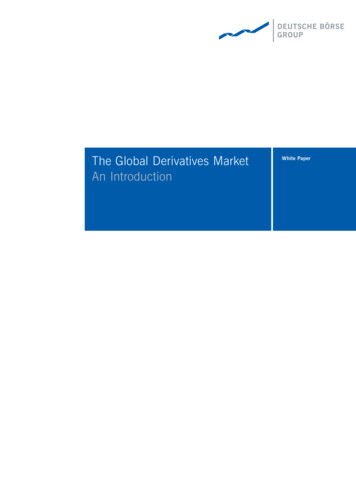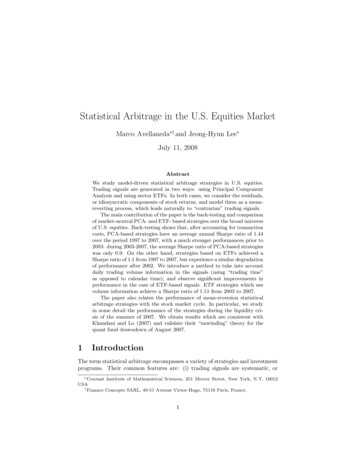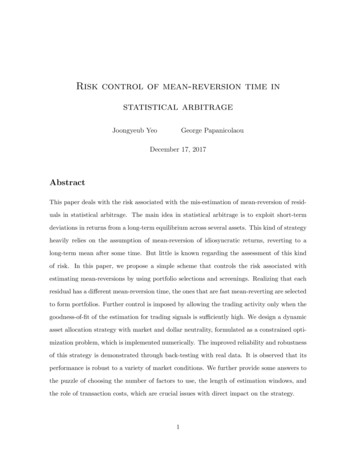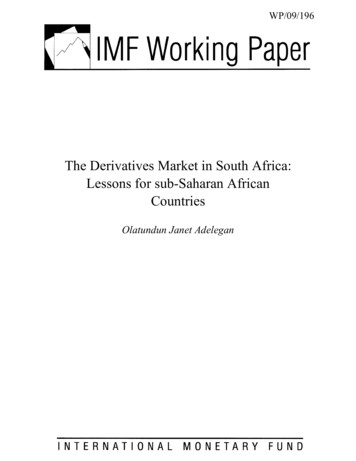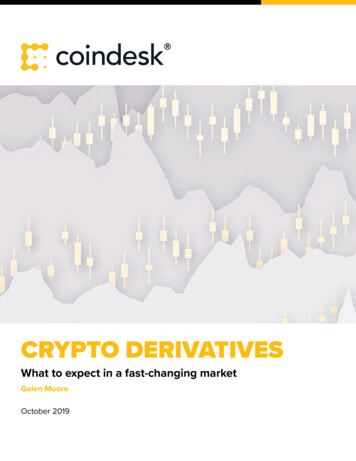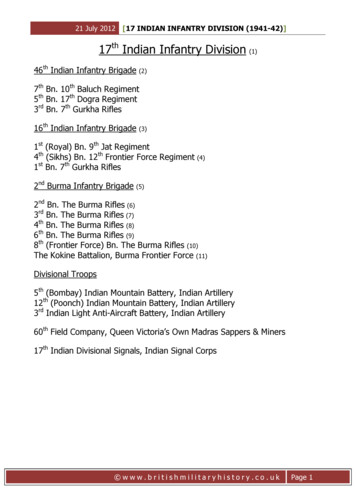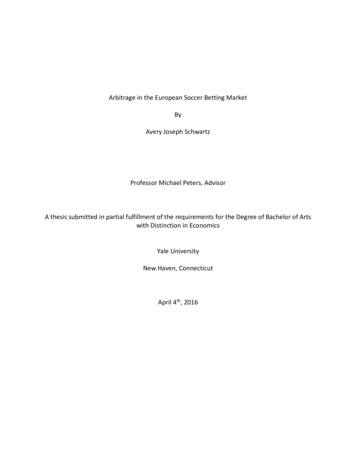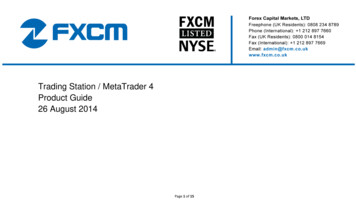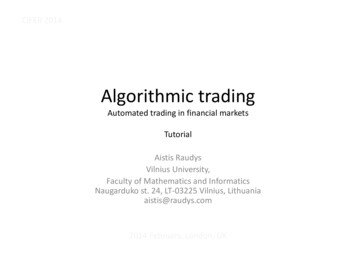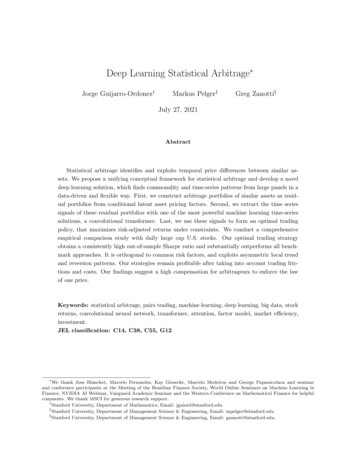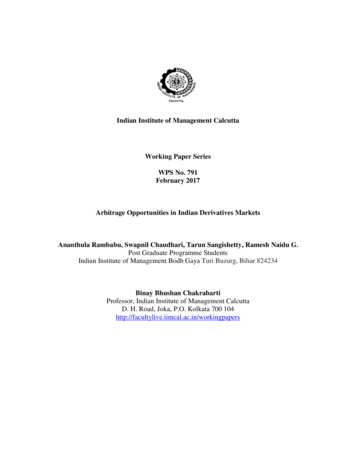
Transcription
Indian Institute of Management CalcuttaWorking Paper SeriesWPS No. 791February 2017Arbitrage Opportunities in Indian Derivatives MarketsAnanthula Rambabu, Swapnil Chaudhari, Tarun Sangishetty, Ramesh Naidu G.Post Graduate Programme StudentsIndian Institute of Management Bodh Gaya Turi Buzurg, Bihar 824234Binay Bhushan ChakrabartiProfessor, Indian Institute of Management CalcuttaD. H. Road, Joka, P.O. Kolkata 700 104http://facultylive.iimcal.ac.in/workingpapers
ARBITRAGEOPPORTUNITIESIN INDIANDERIVATIVESMARKETSProf. B. B. Chakrabarti(Retd. Faculty IIM Calcutta)bbc@iimcal.ac.inAnanthula Rambabuananthula.rambabu2017@iimbg.ac.inSwapnil Chaudharichaudhari.swapnil2017@iimbg.ac.inTarun Sangishettysangishetty.tarun2017@iimbg.ac.inRamesh Naidu G.gavinda.ramesh2017@iimbg.ac.in(PGP students of IIM Bodhgaya)
Arbitrage Opportunities in Indian Derivatives MarketArbitrage Opportunities in Indian Derivatives MarketProf. B.B.Chakrabarti, A. Rambabu, Swapnil Chaudhari, Tarun Sangishetty, Ramesh NaiduAbstract:Two portfolios with the same payoffs should be priced similarly if it doesn’t happen,then there exists an arbitrage opportunity where the trader can make a profit, the trader can sellthe higher priced portfolio and buy the cheaper portfolio. Arbitrage brings back prices of suchportfolios to their fundamental price. According to Classical theories such arbitrageopportunities arise due to market inefficiencies and are taken care by the market consisting ofrational investors and arbitrageurs. In reality these inefficiencies/opportunities do persist fromtime to time - due to information asymmetry and various other risks associated with performingthe arbitrage. We have surveyed literature discussing the limitation to arbitrage and researchrelated to arbitrage opportunities in financial markets. In this paper we find such arbitrageopportunities using the NIFTY 50 stocks. The paper is divided into two sections – the Spotfutures and Put-Call options. The mispricing in spot and futures markets have been found instocks such as IDEA, ONGC, BPCL, COALINDIA, BHARTIARTL, INDUSINDBK, GAIL,YESBANK, KOTAKBANK, AUROPHARMA, BANKBARODA, TATAPOWER,MARUTI, HCLTECH, HEROMOTOCO, ICICIBANK. All the stocks are found to be in thenormal backward markets. Some of the profits after all the transaction expenses are deductedare as follows: BPCL – Rs.3.08 per share; COALINDIA – Rs.1.48 per share; BHARTIARTL– Rs.1.25 per share; MARUTI – Rs.1.35 per share. The mispricing in spot and options marketwere also found in various stocks such as BHEL, BHARTIARTL (on the date:2/2/2107). Theprofits at different strike prices are shown in the results sections.Keywords: Arbitrage, Spot-futures parity, Put-Call parity, market inefficienciesJEL Classifications: G13, G14, G021.1. Introduction:An arbitrage is the simultaneous purchase and sale of an asset to profit from a differencein the price. It is a trade that profits by exploiting the price differences of identical or similarfinancial instruments on different markets or in different forms. Arbitrage is described as riskfree because participants are not speculating on market movements. Instead, they bet on themispricing of a share/asset that has happened between two related markets. Therefore,Arbitrage exists as a result of market inefficiencies. Classical theories suggest that the market,assuming it has rational investors and arbitrageurs, take care of the mispricing and brings backthe prices of the assets to their fundamental price. But in reality these mispricing do persistfrom time to time.So, now the question arises – “Why do the inefficiencies persist?” The answer to thisquestion can be understood from the learnings of the groundbreaking research papers: Shleiferand Vishny (1997) and Barberis and Thaler (2003). These papers discuss about the real-worldarbitrage and frictions that are associated with it, which make these inefficiencies to persist.1
Arbitrage Opportunities in Indian Derivatives MarketTheoretically if we have two securities giving the same payoffs in time, then the twosecurities must be priced same, this is also intuitively understood from the law of one pricing.Even the Efficient market hypothesis states the same – when there are anomalies in pricing ofa security, i.e. the price of the security, if it moves away from its fundamental value then therational investors and the arbitrageurs would come into picture and drive the misplaced priceback to the fundamental value and hence eliminating the misplaced price. But in reality theinefficiencies or the misplaced pricings would still persist.The persistence of these inefficiencies suggests that there are serious limitations toarbitrage. In practice, arbitrage strategies are risky and costly. There are various risks and thecosts associated with the arbitrage.1. Fundamental risks: Fundamental risks refer to the risk that new bad information may arriveto the market after you have purchased the security. In any arbitrage, a trader has to take along position of the lower priced security, the trader takes a long position suspecting thatthe lower priced security would converge to its fundamental value and hence makinghim/her profit. But still this security is prone to fundamental risk i.e. its price may still godown. Theoretically this risk can be perfectly hedged by buying a closely related security.Unfortunately substitute securities are rarely perfect, making it impossible to remove all thefundamental risk.2. Noise trader risk: Noise trader risk refers to the risk that the mispricing worsens in theshort run because there is possibility that pessimistic traders become even more pessimisticabout the future. Once a position is taken, noise traders may drive prices farther fromfundamental value, and the arbitrageur may be forced to invest additional capital, whichmay not be available, forcing an early liquidation of the position.3. Information gap and financing issues: Generally, the arbitrageurs are informed but wealthconstrained and the investors are uninformed and wealthy. In a situation where noise traderrisk rises and the mispricing worsens and the fund has to pay lot of margin calls to hold theposition, the investors may panic and the arbitrageur might face financing issues to carry onwith his arbitrage strategy. The investor might doubt arbitrageur’s abilities and they mightwithdraw their precisely when the expected gain is at the maximum – lost opportunity whichcould have covered all the expenses incurred till now. This might make the arbitrageur toparticipate less in such similar trades in the future.4. Implied Volatility: As implied volatility rises, the options prices will also rise (predictedby the Black-Scholes options pricing formula) this may affect the prices for the longpositions adversely in some situations and decrease the overall expected profits. Alsoimplied volatility is different from the historical volatility, it is the market’s expectations ofthe stock’s price volatility in the future. As this implied volatility rises, risk associated withthe option raises so arbitrageurs expect more returns. Present market arbitrage value maynot be as great as the expected returns of the arbitrageurs.2
Arbitrage Opportunities in Indian Derivatives Market5. Portfolio management issues: arbitrage opportunities are short time and involves hugeamount of money which has huge opportunity cost. Portfolio managers may not willing todisturb their portfolio for these short term profits.6. Liquidity: Liquidity in the stock and futures segments or the options market contribute tothe uncertainty, and therefore risk. In an arbitrage trade, when trader has to take longpositions, if the liquidity is less then he may not find the securities to buy. In futures andoptions we buy in lots - and when we execute the contract we need to take delivery or buyfew hundreds of stocks per lot, if liquidity is less, the trader may not be able to purchase thedesired number of stocks at the given price. Also futures and options contracts usually getsquared off at expiration date. The trader has to sell the stocks before the market closes onthe expiration date. If for some reason, there isn’t enough liquidity then the trader can’t shortthe stocks and this may give rise to losses to the fund – since the entire profit can’t beattained and the short position can’t be taken over to the next month because of lack ofopportunity.7. Implementation costs: These refer to the transaction costs such as commissions, bid-askspreads, premium payments and margin payments. Along with these costs there are othercosts related to finding and learning about a mispricing, as well as the costs of the resourcesneeded to exploit it – the state of the art technology and IT infrastructure that can trade athigh-frequency speeds.1.2. Literature survey:This paper relates to the literature of the few research papers we have referred to studyand understand the Arbitrage opportunities in various financial markets in the world.In the paper, ‘Arbitrage opportunities in the futures market: A study on NSE NIFTY 50’by Dr.Dheeraj Mishra, Dr.R.Kannan, Dr.Sangeeta Mishra, the failure of the spot-futures paritywas studied. The various factors such as time to maturity, rising or declining of markets,markets being in Contango or Normal Backwardation, were examined to check the parity. Thepaper finds that the parity fails in some stocks. It was found that the arbitrage profits werehigher for far the month futures contracts than for near the month futures contracts.In the paper ‘DAX index futures: Mispricing and arbitrage in German markets’ byWolfgang Buhler and Alexander Kempf we see that again the spot futures securities which aremispriced. The paper suggests an arbitrageur trade mainly in futures nearest to delivery. It alsosuggests that the risk associated with arbitrage trading is found to be very small so that theprofits are nearly risk free.In the paper ‘Price discovery and arbitrage efficiency of Indian equity futures and cashmarkets’ by Dr.Balwinder singh, the author finds that strong and long run relationship existsbetween equity futures and cash markets. However, during short run significant deviations havebeen observed. It was empirically found that price discovery happens in both the markets butthe futures markets dominates the information transmission process.3
Arbitrage Opportunities in Indian Derivatives MarketSince mispricing happens in the derivatives markets, we reflect upon the paper ‘IndexArbitrage between Futures and ETFs: Evidence on the limits to arbitrage from S&P 500futures and SPDRs’ by Nivine Richie and Robert Daogler. The paper examines how longmispricing lasts and the impact of volatility on mispricing. It was found that the mispricing wasfar more frequent in high volatility months than in low volatility months. The duration ofmispricing was found to be independent of the monthly level of volatility.Having stated that the arbitrage opportunities exist from time to time, the purpose ofthis paper is to study the NIFTY 50 stocks to find out such opportunities in the India stockderivatives market. The paper is organized as follows: In the section 2.1 we explain thepossibilities of any mispricing of the Spot and Futures contracts. We define the Spot-Futuresparity. We suggest two scenarios how these mispricing happen. In section 2.2, the classificationof the stocks into Contango and Normal backwardation is discussed and suitable arbitragetrading strategies are discussed. In section 2.2.1, the notations for the various inputs and theirdata sources to our model have been stated. In section 2.2.2, the risk free rate calculations havebeen discussed. In section 2.2.3, the arbitrage strategies applied in our approach have beenstated. In section 2.2.4, the details regarding the transaction costs applicable to carry out thearbitrage trade have been stated. In section 2.3, the results consisting the profits after deductingthe various expenses have been mentioned for the Spot-Futures markets. Section 2.4 consistsof discussion about the results of the Spot-Futures markets.In section 3.1, we explain another parity condition between two portfolios – onecontaining the Put option on the stock and the stock itself and the second portfolio consistingof the Call option on the stock and a bond (or the cash to cover the purchase of the stock, i.e.to cover the call on the date of expiration). In section 3.2, we discuss the model used to describethe parity, the notations used for the various inputs used for our model have been stated in thissection. We explain the arbitrage strategies that are used on the NIFTY 50 stocks. The viabilityof an easy arbitrage opportunity has been shown using a stock example. In section 3.2.1, thecalculations related to the transaction expenses have been discussed. Further in the stockexample, we arrive at the riskless profit that can be made. The methodology that has been usedto explain the stock example has been implemented to calculate similar arbitrage opportunities.Finally, in section 3.3, we arrive at profits after deducting trade expenses for the NIFTY 50stocks used in our research. Section 3.4 consists of discussion on results of the arbitrageopportunities in options market. Section 4 states the various assumptions of our study. Section5 concludes the discussion.4
Arbitrage Opportunities in Indian Derivatives MarketStock Futures Arbitrage2.1.Problem description: Arbitrage opportunities in the Spot and FuturesmarketIn normal market conditions, futures price would be greater than the spot price becauseof the effect of cost of carry and it moves in tandem with the price of the underlying asset.Thus, based on the cost of carry principle, if the spot price of a share on a given day is ‘x’ then,the futures price on that day would be ‘x’ the interest for holding the spot to the duration offutures contract ( minus) any dividend accrued on the spot.So, to compute the cost of carry accurately a participant needs accurate information oninterest rates and expected dividends. However, futures market is not so perfect where all therequisite information is readily available to all. Imperfections are common and that results in amismatch between spot and futures price based on the cost of carry principle.When this logic between spot and futures does not hold, the futures are incorrectlypriced and that results in arbitrage opportunities.Spot-futures parity:It is a parity condition whereby, if an asset can be purchased today and held until theexercise of a futures contract, the value of the future should equate the current spot priceadjusted for the cost of money, dividends, convenience yield and any carrying costs (such asstorage). When the relationship between spot and futures does not hold, the futures areincorrectly priced and that results in arbitrage opportunities. The mathematical representationof the theoretical relationship between the spot and futures price can be put into the followingequation:Theoretical Futures price Spot price (1 risk-free interest rate – income yield – convenience yield)tIf we assign a single ‘r’ to be the equivalent cost of carrying the asset (that is, the sumof interest, dividends, convenience and storage), then we can simply put this relation to beequivalent to:𝑭 𝑺𝟎 𝒆𝒓𝒕(1)NOTE: We use continuous compounding formula in equation (1), this is done for simplicitysake since the duration is small (less than a month), the above equation can be used forapproximately similar results. The value of rate of interest for the above equation, adjusted forcontinuously compounding, can be described using the formula where𝒓𝒄 𝒎𝒍𝒏(𝟏 𝒓𝒎𝒎)(2)Where, rc is the continuous compounding rate of interest, rm is therisk free rate (the durationtill the expiry of the futures contracts) and m which is equal to (duration till expiry)/365.5
Arbitrage Opportunities in Indian Derivatives MarketThe equation (1) describes that the futures contract should be for a strike price equivalent to F.When the futures price doesn’t follow the parity condition described above, then there are twocases which can arise, they are as follows:1. The actual futures price (F0) is greater than the theoretical futures price F2. The actual futures price (F0) is less than the theoretical futures price FIn each case the arbitrageur has a risk less opportunity to make profit, the arbitragestrategy is discussed further in the following sections.The research conducted in this thesis is done on the NIFTY 50 stocks. The spot pricesand the one month future prices are recorded and the spot-futures parity is examined to checkif the parity holds or not. Each of the stocks are examined individually and an Excel basedmodel is created to run the calculations to find out the arbitrage profit that can be collected bythe arbitrageur. The model has been described elaborately in the methodology section, whichfollows below. The methodology will categorize each case and delineate the arbitrage strategiesthat need to be used in a particular scenario. The data sources have been stated after themethodology section.2.2. Methodology:This section discusses the methodology to conduct the arbitrage in the two cases thatcan occur. The two possible scenarios for a market resulting into arbitrage opportunities havebeen named as Contango markets and Normal Backward markets. They are explained asfollows:Case 1: Contango market: if the spot futures price (F0) is greater than the theoreticalfutures price (S0ert) as suggested by the parity equation, in this scenario the trader canBUY STOCK and SELL FUTURES (Assuming the trader operates in India and alsoassuming that the arbitrageur already possesses the futures)Case 2: Normal Backward market: if the spot futures price (F0) is less than the theoreticalfutures price (S0ert) as suggested by the parity equation then the trader can SELL STOCKand BUY FUTURES (Assuming the trader operates in India and also assuming that thearbitrageur already possesses the stock)These are the only two strategies that any arbitrageur can use to see if he/she makes anyprofit by taking a long position in one market and a short position in another. Having stated thetwo strategies that an arbitrageur can use, we will first categorize any stock into two caseswhich are stated below. For any stock we have its respective spot futures price & its spot price.For any arbitrage strategy applied, as discussed above, we have a long position and ashort position. In the long position we will be dealing with the ask price of the asset and in theshort position we will be dealing with the bid price of the asset. In futures contract we mustpay margin amount to the exchange so we need to consider the interest we lost on the marginamount to calculate the net value of arbitrage opportunity.6
Arbitrage Opportunities in Indian Derivatives MarketNOTE: In our research we have taken the one month futures contracts which is going to expirein coming 19 days, therefore the risk free interest rate is also for 19 days duration.Notations mentioned below are used in further calculations.r is Risk free interest rate, t is Time duration (19 days), S0a is the Ask price of the stock in spotmarket, S0b is the Bid price of the stock in Spot market, F0a is Ask price in future market, F0bis the Bid price in future market, F1 is the theoretical spot futures price2.2.1 Data sources:1. NSE India1 - NIFTY 50 stocks are chosen to form the underlying asset in the arbitragetrades. The appropriate data regarding the stock spot and futures prices are collected fromthe NSE website2. RBI2 – The data for the call money rate and 91 day T-bill rate used for the risk free ratecalculations were taken the RBI website.3. Zerodha3 –The data used for calculating the transaction charges is taken from this website2.2.2 Risk free rate calculation:The above data have been collected on 9th January, 2017. The Call money rate as on 9th January2017 was 6.12%. The 91 days T-bill rate was 6.19%. The number of days for the futurescontract expiration is 19 days.The risk free rate is 6.12% (6.19%-6.12%)*19/90.Therefore, the interpolated risk free rate 6.13%. This rate of interest is used in equation (1).1.2.3.THE NATIONAL STOCK EXCHANGE OF INDIA LIMITED IS THE LEADING STOCK EXCHANGE OF INDIA, LOCATED INMUMBAI. NSE WAS ESTABLISHED IN 1992 AS THE FIRST DEMUTUALIZED ELECTRONIC EXCHANGE IN THE COUNTRY- HTTPS://WWW.NSEINDIA.COM/RBI.ORGZERODHA IS AN INDIAN FINANCIAL SERVICES COMPANY THAT OFFERS BROKERAGE-FREE EQUITY INVESTMENTS,RETAIL AND INSTITUTIONAL BROKING, AND CURRENCIES AND COMMODITIES TRADING.HTTPS://ZERODHA.COM/CHARGES7
Arbitrage Opportunities in Indian Derivatives Market2.2.3 Arbitrage Strategies:Table 1: Arbitrage Strategy in Case 1If F1 F0 : BUY STOCK SELL FUTURESTime ActionNow Borrow Spot price and Margin moneyto buy Short Futures contract @ Riskfree rateBuy stock at Spot price and buy Shortfutures contractAt t: Deliver on Future (sell stock @ F0b)and receive margin money backPay back the loan with interestCash flow(S0a Margin%* F0b)*lot size-(S0a Margin%*F0b)*lot sizeF0b*lot size margin money paid before-((S0a margin%*F0b)*lot size )*(1 r)t sayA(1 r)tNCF F0b*lot size margin money - A(1 r)tTable 2: Arbitrage Strategy in Case 2If F1 F0 : SELL STOCK BUY FUTURESTime Action:Sell Stock at Spot price and buy LongNowfutures contractLend money @ risk free rateAt t: Collect money on loan with interestBuy stock @ FaReceive margin backCash flow(S0b – F0a*margin%)* lot size say BBBertF0a*lot sizeF0a*margin%*lot sizeNCF (B(1 r)t Margin money) – F0a*lotsize2.2.4 Transaction expenses:In the above analysis the Net cash flows from each of the arbitrage strategies is given,but in a real scenario we also have other expenses that go into the transactions mentioned above.These are as follows: Brokerage charges, SEBI Charges, Stamp charges, Securities transactiontax, NSE Transaction charges & Service Tax.We also deduct these charges which are applicable accordingly. After deducting thesecharges we arrive at the final arbitrage profits that the arbitrageur could actually receive.8
Arbitrage Opportunities in Indian Derivatives MarketTable 3: Zerodha Charge sheetZerodha chargesEquity deliveryEquity futuresBrokerageZero Brokerage0.01% or Rs. 20/trade whichever is lowerSTT/CTT0.1% on buy & sell0.01% on sell sideNSE: 0.00325%BSE: 0.00275%MCX-SX: 0.002%15% on (brokerage transaction charges)NSE: 0.0021%BSE: 0.0007%MCX-SX: 0.0014%15% on (brokerage transactioncharges) 20 / crore* 20 / crore*TransactionchargesService taxSebi charges2.3.Results:Positive Arbitrage profits are found for stocks: IDEA, ONGC, BPCL, COALINDIA,BHARTIARTL, INDUSINDBK, GAIL, YESBANK, KOTAKBANK, AUROPHARMA,BANKBARODA, TATAPOWER, MARUTI, HCLTECH, HEROMOTOCO, ICICIBANK.Assuming the trader would have certain cut-offs regarding the profits per share (say Rs 1.20per share minimum), we recommend the following stocks:Table 4: Results from Stock – Futures Arbitrage2.4COMPANYMARKET TYPEARBITRAGE PROFIT (RS)BPCLNORMAL BACKWARD3694.95Profit pershare3.08COALINDIANORMAL BACKWARD2521.661.48BHARTIARTLNORMAL BACKWARD2131.621.25MARUTINORMAL BACKWARD202.471.35Analysis of results:The above section shows that there exist arbitrage profits that can be made using thespot and futures markets. We observe that the recommended stocks have their futures contractsin the normal backward market. Since a trader would have to short the stock and buy futures,the trader has to have the stock in his/her possession. He would either own the stock or borrowit from some lender, in each case the rate of returns would vary.Let’s take the stock BPCL, it can be seen that the profits made by trading on single lotof stock is Rs.3694.95 – which is realized in the normal backward market. Now, if the traderdoesn’t own the stock then he/she would have to borrow the stock, assuming he/she borrowsunder the SLB mechanism. Say the trader borrows single lot of stock, so for BPCL it is 1200shares, and then under the SLB mechanism the trader has to pay a margin to the intermediary9
Arbitrage Opportunities in Indian Derivatives Marketlike ILFS (Infrastructure leasing and financial services Ltd.), the margin for a borrower is 125%of the stock value (worth Rs.664.25*1200*1.25). In this case, it would be equal to roughlyRs.9.96 lakhs. Also the margin for single lot of futures contracts is around Rs.1.1 lakhs. Hencefor the trader, total money blocked is around Rs.11 lakhs. So the return on blocking Rs.11 lakhis (3694.95/1100000) roughly 0.33%. Assuming, the trader has to pay for interest costs ofborrowing the asset from the lender, the rate of return would further decrease. We should noticethat this return is for 19 days, and also that the return is lesser than the return he would get ifhe/she invested the same Rs.11 lakh worth of amount in a fixed deposit.Same goes with the trader who owns the stock, even he/she would face almost thescenario except that the trader here would sell stock, receive cash, pay margin money forfutures, invest remaining amount in a bank till the contract expiry date, take out money, andbuy the stock at expiry of futures at strike price. Therefore, in either of the case i.e. the traderowns the stock or borrows it, the trader would have a meager rate of return which is not worththe complex actions that need to be taken. This can be one of the reasons that the mispricingcontinues to persist in the financial markets - since the trade is not worth the expected profits.In today’s technologically advanced era these trades of spot and futures arbitrages are doneusing super computers in hedge funds where the asking rate of return would be higher than therate of return we would actually receive, therefore, few such opportunities do persist longer.10
Arbitrage Opportunities in Indian Derivatives MarketStock options arbitrage opportunities in Indian financial markets3.1 Problem Statement:PUT-CALL parity:If a trader has two portfolios consisting of a Stock A and a put option on the stock (atstrike price: X) and another portfolio with a Bond which at maturity gives X (strike price) worthof money and a Call option on the stock with a strike price of X again. Considering both thecall and put options have the same date as the maturity date, then we can say that the twoportfolios will have the same payoffs whatever be the price of the stock in the future on thematurity date. This can be understood using the payoff graphs for each of the portfolio.Fig. payoff diagrams for PUT STOCK and CALL BOND portfoliosCALL BOND:PUT STOCK:The two portfolios at maturity will give the same payoff value so if the total price ofeach of the portfolio doesn’t happen to be same now, then we have an arbitrage opportunity. Atrader can then buy the cheaper portfolio and short the costlier portfolio to make a risk lessprofit.3.2 Methodology:Our research is based on the NIFTY 50 stocks. We have taken two portfolios consistingof a PUT STOCK and another with the CALL BOND (T-Bill). Both the options have thesame strike prices and the same maturity dates. The Bond matures at a risk free rate. The riskfree rate calculations are mentioned below:The risk free rate is interpolated using the call money rate and the 91 T-bill rate.11
Arbitrage Opportunities in Indian Derivatives MarketRisk free rate for required number of days Call money rate (91 day T-bill rate – Call moneyrate)*number of days /365. We then find the rate adjusted for continuous compounding suingthe equation (2), then substitute in the equation (3) The PUT-CALL parity is denoted asfollows:𝑃 𝑆0 𝐶 𝑋𝑒 𝑟𝑡(3)Where, P is price of PUT option, C is Price of CALL option, S0 is the current Stock Price, X isthe Strike price of option contract, and r is the Risk free rate.When the above equation doesn’t hold, then there exists an arbitrage opportunity and the tradercan make a riskless profit. There arise two cases:Case 1: PUT STOCK portfolio is priced more, CALL BOND is priced less. In this situationwe sell the PUT STOCK portfolio and buy the CALL BOND portfolio, take a LONGCALL at Ask price LONG BOND and carry a SHORT PUT at Bid price SHORTSTOCK at Bid priceCASE 2: CALL BOND portfolio is priced more, and the PUT STOCK is priced less. Inthis situation we sell the CALL BOND portfolio and buy the PUT STOCK portfolio takea LONG PUT at Ask price LONG STOCK at Ask price and carry a SHORT CALL atBid price SHORT BONDThe calculations have been done using an excel model and the methodology has been discussedbelow using a real stock example.Name of the stock: BHARTIARTL (Bharti Airtel)Lot size: 1700, ASK price: 349.85, BID price: 349.75Let’s take the strike price of the stock option X 360The put and call ask-bid prices are given below:Table 5: Bid-Ask Prices of Call &Put for BHARTI AIRTELCALLPUTBIDASKBIDASK3.83.9525.85 29.35CASE 1: LONG CALL LONG BOND and SHORT PUT SHORT STOCKAsk price CALL PV of Bond 644640Bid Price PUT BID price of STOCK 618460Opportunity doesn’t existCASE 2: LONG PUT LONG STOCK and SHORT CALL LONG BONDAsk price PUT Ask price of STOCK 638520Bid price CALL PV of BOND 618715Opportunity 638520-618715 19805 riskless profit can be madeNow keeping this real stock example in picture we need to deduct other expenses that we haveincurred to execute this arbitrage strategy.12
Arbitrage Opportunities in Indian Derivatives Market3.2.1. Transaction expenses:There are various expenses that need to be mentioned, they are as follows: Interest loston margin payments, Interest expenses on the borrowed money, Brokerage charges, SEBICharges, Stamp charges, Securities transaction tax, NSE Transaction charges, Service taxThe table below lists the appropriate transaction charges and taxes associated with the equityand equity options:Table 6: Zerodha Charge SheetZerodha yZeroBrokerage0.1% onbuy & sellNSE:0
trading strategies are discussed. In section 2.2.1, the notations for the various inputs and their data sources to our model have been stated. In section 2.2.2, the risk free rate calculations have been discussed. In section 2.2.3, the arbitrage strategies applied in our approach have been stated.
